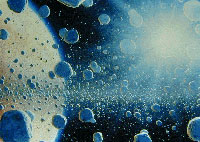Saturn rings still remain mysterious for modern scientists
Saturn planetary rings are three rings that are perfectly seen from the surface with the help of a telescope. They are the external A ring of average luminance, the middle B ring of the highest brightness and the inward semi-transparent C ring. The rings are slightly whiter than the yellowish disc of Saturn. They are located in the plane of the planet’s equator. Their radial length makes up about 60,000 km, and the rings are very thin for this length (less than three kilometers).

It was estimated with the help of a spectrograph that revolution of the rings is not typical of solid bodies: the farther from Saturn the lower the velocity. What is more, every spot on the rings has a speed that a moon orbiting Saturn freely could have had at this distance. The Saturn rings turn out to be a huge cluster of tiny solid particles on their individual orbits around Saturn. These particles are so small that they can be seen neither from surface telescopes nor from board of spaceships.
The structure of the rings has dark annular sectors with maxima and minima in density and brightness. The widest of them is 3,500 km wide, a region between the A ring and B ring. It is known as the Cassini Division named after the astronomer who saw it first in 1675. These regions were considered to be of a resonance nature. As for the Cassini Division, ring particles at this location orbit twice for every orbit of the moon Mimas. The resonance causes Mimas’ pulls on these ring particles to accumulate, destabilizing their orbits and leading to a sharp cutoff in ring density. Voyagers discovered that at a close distance the Saturn rings resemble a gramophone record: they are stratified into thousands of thin ringlets with dark gaps between them. Many of the gaps can not be explained just with the orbital resonance with Saturn’s moons. How did the thin structure appear? It is likely that even distribution of particles about the rings’ surface is mechanically unstable as a result of which circular waves of density get formed. And they are the thin structures we observe.
Voyagers discovered four other rings in addition to the A ring, B ring and C ring. The D, E, F and G rings have very low density and thus are rather pale. The D ring and E ring are hardly seen from the surface under especially favorable weather conditions; the F ring and G ring were discovered for the first time. The marking of the rings is explained with historical reasons and disagrees with the alphabetic order. Here are the rings’ indications given from the center to the periphery: D, C, B, A, F, G, E.
The F ring gave rise to great interest and much discussion. Unfortunately, there is no definite idea of the object as observations presented by both Voyagers that studied them are contradictory. Voyager-1 determined that the F ring consisted of several ringlets each 60 km wide, and two of them are interlaced like a lace. For a rather long period of time it was believed that the ringlets were interlaced because of two newly opened moons close to the F ring. The gravity of the two moons does not let the outward particles go too far from the center. It was also estimated that they make the particles move in a wavy way and eventually cause the rings’ interlacing. But Voyager-2 that passed Saturn nine months later discovered neither interlacing nor other deformations within the F ring structure. Nothing of the kind was discovered in the close vicinity of the above mentioned newly opened satellites. So, it turned out that the F ring form is inconstant. And two separate observations are not enough to speak about the reasons and regularity of the changeability. What is more, modern equipments do not allow to survey the F ring from the surface as it is very pale. A closer study of the pictures made by the Voyagers will hopefully unveil the mystery.
The D ring is the closest one to the planet and obviously stretches up to Saturn’s cloudy sphere. The E ring is the outermost ring and extremely wide, about 90,000 km. It takes from 3.5 to 5 radiuses of the planet. Density of the E ring increases toward the orbit of Saturn’s moon, Enceladus. It is likely that Enceladus is the source of the E ring’s material.
Particles of the Saturn rings are highly likely icy and covered with hoar-frost. The information was first obtained with the help of observations made on the surface and later confirmed with observations of spacecrafts.
When Voyager-1 passed by Saturn very close its radio transmitter pierced the A ring, the Cassini Division and C ring on a wavelength of 3.6 cm with a radio beam. Then the radio-frequency radiation was sent to the Earth for further analysis. It turned out that particles of the stated areas diffuse radio-waves forward and do it in slightly different ways. The analysis allowed estimating the diameter of the A ring particles (10 m), the Cassinii Division (8 m) and the C ring (2 m).
Dispersion forward is also strong with the F ring and E ring which means that they contain a high amount of fine dust.
A new structure element was discovered in the B ring which are radial formations called ‘spokes’ for their resemblance to wheel spokes. They also consist of fine dust and are located above the ring surface. It is not ruled out that electrostatic repulsion holds them there. It is incredible that drawings of Saturn made in the past century also contain the spokes.
When the Voyagers examined the rings they suddenly detected numerous brief bursts of radio-frequency emission coming from the rings. Those were signals of electrostatic discharges emerging from particles collision.
A gaseous atmosphere of neutral atomic hydrogen was also discovered around the rings. The Voyagers estimated that one cubic centimeter of the atmosphere contained about 600 hydrogen atoms. It was long before launching spacecrafts to Saturn that some researchers supposed that the Saturn rings could have atmosphere.
The Voyagers also made efforts to measure the rings’ weight. The problem was that the rings weighted at least one million times less than the weight of Saturn. And because of it the trajectory of a spacecraft close to Saturn is determined by the planet’s strong attraction and just slightly disturbed by low attraction of the rings. Further investigation determined that the weight of the rings was certainly less than 1.7 part per million of the planet’s weight.
Translated by Maria Gousseva
Pravda.ru
Subscribe to Pravda.Ru Telegram channel, Facebook, RSS!




